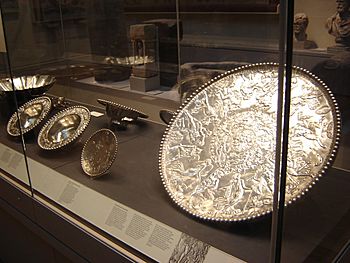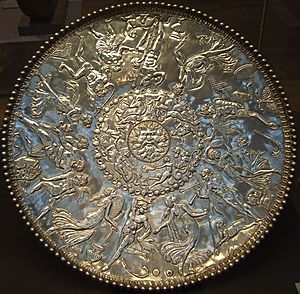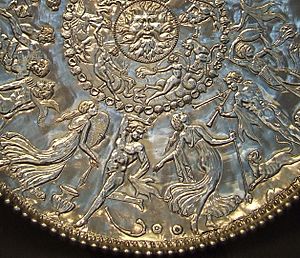Mildenhall Treasure facts for kids
Quick facts for kids Mildenhall Treasure |
|
|---|---|
|
Mildenhall Treasure in the British Museum
|
|
| Material | Silver |
| Created | 4th century AD |
| Discovered | 1942 |
| Present location | British Museum |
The Mildenhall Treasure is a huge collection of 34 amazing silver dishes, plates, and spoons from the Roman Empire. These items were made in the 300s AD. They are the most valuable Roman objects found in Britain, both for their art and their weight in silver.
This treasure was found in 1942 near Mildenhall, a town in Suffolk, England. It includes over thirty pieces, with one giant plate called the Great Dish that weighs more than 8 kilograms!
Today, you can see the Mildenhall Treasure at the British Museum in London. It's a very important and valuable collection. You can also see copies of the treasure at the local museum in Mildenhall.
Contents
How the Treasure Was Found
The treasure was discovered in January 1942 by a farmer named Gordon Butcher. He was ploughing his field when he hit something hard. With help from Sydney Ford, who he worked for, they dug up the items.
Many details about how it was found are still a bit unclear. This is partly because it happened during World War II. It seems they didn't realize how important the objects were at first. Sydney Ford, who collected old things, cleaned the pieces.
He even used some of them every day! The Great Dish was used for special family events. Ford finally told the authorities about the treasure in 1946. This happened after a friend who knew about old objects saw them at his house.
Later that year, the treasure was officially declared "treasure trove". This meant it legally belonged to the Crown. The British Museum in London then bought it.
At first, some experts found it hard to believe such beautiful Roman silver came from Britain. There were many rumors and doubts. But since then, many other high-quality Roman items have been found in Britain. One example is the Hoxne Hoard, also found in Suffolk. These new finds prove that the Mildenhall Treasure is a real British discovery.
A writer named Roald Dahl even wrote a story about the treasure's discovery. It was partly fictional. Ford's grandson later confirmed that Ford knew how important the find was. He just didn't want to give it away. He kept it secret and cleaned it. But two spoons he left out were seen by a visitor, Dr. Hugh Fawcett.
Gordon Butcher and Sydney Ford each received £1000 for finding the treasure. This was a reward, even though the find wasn't reported right away.
Seeing the Treasure and Learning About It
The Mildenhall Treasure went on display at the British Museum right after it was bought in 1946. It has been a main attraction in the museum's Roman Britain section ever since. Sometimes, parts of it are lent out for special exhibits.
Experts have written several books and papers about the treasure. John W. Brailsford published the first short guide soon after it was found. Later, Kenneth S. Painter wrote a more detailed study in 1977. The Great Dish, the most famous piece, has been shown in countless books and articles.
The British Museum has also recently published a very detailed study of the entire treasure.
What's Inside the Treasure?
The Mildenhall Treasure is made up of silver tableware from the 300s AD. It was probably hidden sometime in that century. Most of the objects are quite large and show amazing craftsmanship.
The collection includes:
- Two large serving platters.
- Two small decorated serving plates.
- A deep bowl with wavy edges.
- A set of four large decorated bowls.
- Two small decorated bowls.
- Two small dishes on stands.
- A deep bowl with a lid.
- Five small round ladles with dolphin-shaped handles.
- Eight long-handled spoons.
Platters and Dishes
The Great Dish is the most impressive piece. It's also called the Oceanus Dish or Neptune Dish. It measures about 60 centimeters across and weighs over 8 kilograms. Its decoration was made by pushing the silver from the front.
The design has three circles. In the middle, there's a face of a sea-god, probably Oceanus. He has a beard made of seaweed and dolphins in his hair. Around him, there are sea-nymphs, tritons, and other sea creatures.
The outer circle shows scenes from the parties of the god Bacchus. This includes Bacchus winning over Hercules. Hercules looks tired and is helped by two satyrs. Bacchus himself is shown with his panther.
The god Pan is also in the picture, dancing and playing his pipes. There are also dancing Maenads, who were followers of Bacchus, and more satyrs. The whole design shows traditional Roman pagan beliefs and is beautifully made.
Two smaller plates, about 18 centimeters wide, have the same style as the Great Dish. One shows Pan playing his pipes and a maenad playing a double flute. The other shows a dancing satyr with a dancing maenad.
Both of these small dishes have Greek writing scratched underneath. It says "eutheriou," meaning "property of Eutherios." They also have a bold beaded edge, like the Great Dish and other items.
Another large, flat serving platter is almost as big as the Great Dish. It's 55 centimeters wide. But its decoration is very different. It has simple geometric patterns made with black niello (a silver mixture) on its rim and in the center.
Bowls
There's a deep bowl with wavy edges and two small handles. These handles were found detached because the glue used in ancient times can loosen underground. This type of bowl was used to hold water for diners to rinse their hands. The wavy design in the center of the Mildenhall bowl shows a six-pointed star. This was a popular shape in Roman times, not a special symbol.
The covered bowl is very interesting. It's the oldest item in the treasure. We know for sure it was made in Gaul (modern France) in the 200s AD. It has a narrow edge decorated with patterns made with niello. There's also a small nielloed flower in the center.
The lid is tall and domed, fitting perfectly over the bowl. It has two decorated bands. The top band has plant patterns. The bottom band shows centaurs (half-human, half-horse creatures) attacking wild animals. There are also Bacchus masks.
A small knob on top of the lid is a silver-gilt statue of a young triton blowing a conch shell. This statue might have been added later. The lid itself, made in the 300s AD, was definitely added to the bowl later.
There's a set of four bowls with wide, flat rims. These rims have large beads and show traditional Bacchus themes. You can see countryside scenes, many animals (real and mythical), and Bacchus masks. They also have round pictures in the middle of the bowl.
One bowl (30 centimeters wide) shows a hunter attacking a bear. This one is a bit larger than the other three (26.8 centimeters wide). The other three have single heads in profile in their centers: a young woman, a veiled older woman, and a helmeted head. We don't know for sure who these people are.
There's also a matching pair of smaller bowls (16.8 centimeters wide). They are beautifully decorated with beads, plant patterns, and small birds and hares on their rims. They have raised rosettes in their centers. The inside of these small bowls has a delicate wavy pattern.
Dishes on Stands
Two dishes on stands also form a pair. At first, people thought they were stemmed cups, like modern wineglasses. But the plant patterns on the "bases" and the rougher insides of the "cups" show they were used the other way up. They were small, flat dishes (11.5 centimeters wide) on a stem with a bowl-shaped base. Similar dishes were found in the Traprain Law treasure.
Spoons
The rest of the Mildenhall collection includes small eating tools. There are five round-bowled ladles or spoons. There are also eight long-handled spoons, a common type in late Roman times. The round ladles have handles shaped like dolphins.
Only four handles from the Mildenhall ladles survive, and one is broken. Because the handles and bowls were soldered together long ago and separated underground, it's hard to know which handle belongs to which bowl. It's likely there were originally five ladles, and they have been put back together using the existing parts.
The eight long-handled spoons belong to three groups. Three spoons have pear-shaped bowls with plant designs inside. Spoons 29-31 have Christian symbols inside: the Chi-rho monogram (a symbol for Christ) with the letters alpha and omega (first and last letters of the Greek alphabet, meaning "the beginning and the end").
The other two spoons, 27 and 28, have names written in their bowls: PASCENTIAVIVAS and PAPITTEDOVIVAS. "Vivas" means "may you live!" While not only Christian, these sayings were often used by Christians. So, these spoons might also hint at Christian belief.
Hidden Messages
Besides the Christian symbols and names on the spoons, and the "Eutherios" ownership marks on the two small Bacchus plates, some Mildenhall pieces have weight markings. These are scratched in hidden spots, like the bases. They can be hard to read because they might not show the weight of just that one object. Instead, they might show the weight of a whole set it belonged to.
Rich Romans used silver dishes to show off their wealth and good taste. The artistic quality was important. But the actual value of the silver metal was also a big part of their riches. So, they needed to keep track of its weight.
Why the Treasure is Important
The Mildenhall Treasure contains pieces that are among the best examples of Roman art and craftsmanship in the world. We don't know exactly why or when it was hidden, but we know it's from the 300s AD. The decorations show traditional Roman pagan themes, with a touch of the new Christian faith on some smaller pieces. This mix is typical of that changing time in the Roman Empire.
We don't know where objects like the Great Dish were made. But it was probably somewhere in the Mediterranean region.
More metal hoards have been found in Britain since the mid-1900s. This is because of new farming methods, the rise of metal detecting as a hobby, and people knowing more about archaeology. The Mildenhall group is special even among these finds. But in 1946, it seemed too good to have been found in Britain.
Older finds, like those from Traprain Law in Scotland and the Esquiline Hill in Rome, and newer ones, like the Kaiseraugst treasure from Switzerland and the Hoxne hoard, now help us understand the Mildenhall treasure better. They show that very high-quality personal items were indeed used in Roman Britain in the 300s AD. The Mildenhall collection remains a top example of silver tableware from that time.
The Mildenhall hoard was ranked number 7 in a list of British archaeological finds. Experts at the British Museum chose it for a 2003 BBC Television show called Our Top Ten Treasures.





